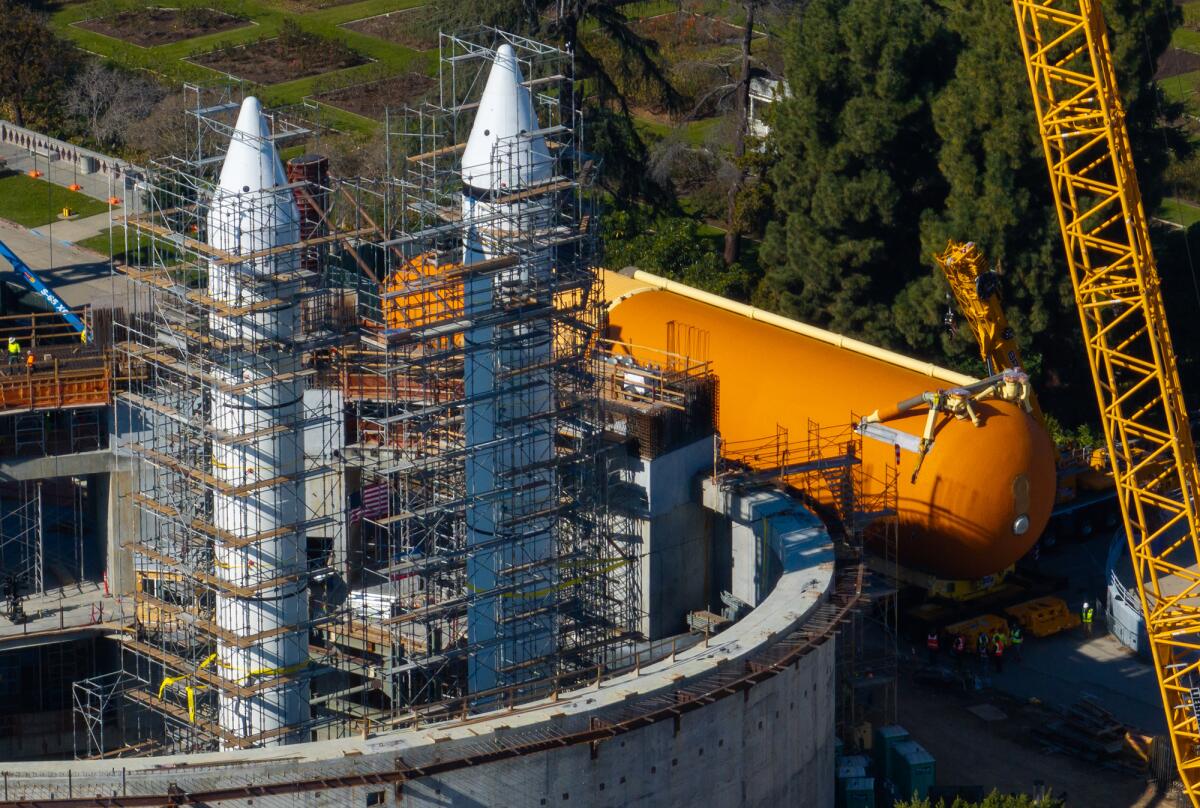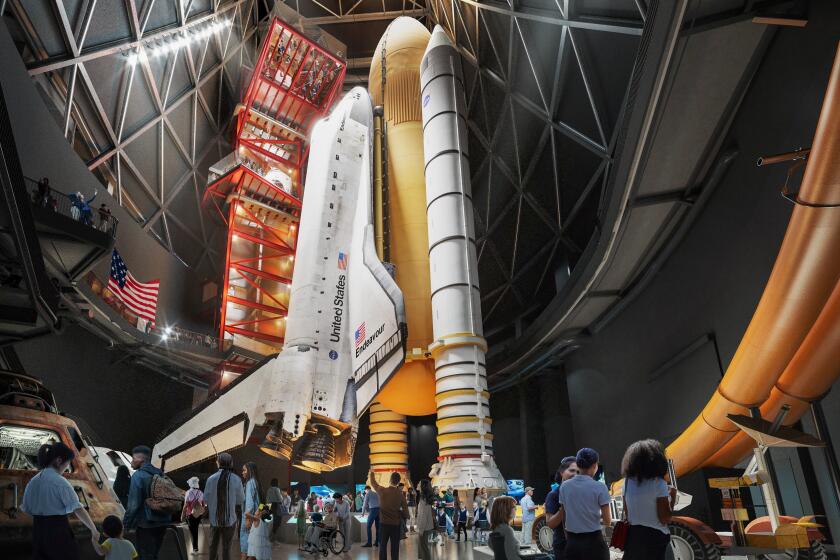Mission accomplished: Space shuttle Endeavour’s giant orange fuel tank moved into viewing spot in L.A.

- Share via
Space shuttle Endeavour’s giant orange fuel tank that propelled astronauts into space on more than two dozen missions was lifted by crane on its final journey and lowered back to Earth early Saturday at its final resting place at the new Samuel Oschin Air and Space Center.
The massive fuel tank — dubbed ET-94 — was carefully positioned vertically between two 149-foot solid rocket boosters before work at the center in Exposition Park was called off about 3:15 a.m., mission accomplished, much to the relief of engineers who have faced some challenges on the complex project, officials said.
Crews had worked 14 hours over the last two days moving the tank, which weighs about 65,000 pounds and is 154 feet long, from storage and lifting it near the boosters before final installation was stopped at 9 a.m. Friday because of dangerous wind gusts.
Workers returned Friday evening and, after five hours, eventually lowered the tank in the gap between the two rockets, coming within two inches of finishing their assignment before work was again halted, this time over a technical issue.
“This is just about done and where you see ET-94 now is where it’s basically going to be,” said Jeffrey Rudolph, California Science Center’s president.
The shuttle’s vertical stack — consisting of the fuel tank and twin rocket boosters — is part of an ambitious new space shuttle exhibit under construction at the space center.
Moving the tank from storage to the exhibit space posed serious challenges for workers. The initial lift was delayed 3½ hours by gusty winds, but crews eventually used two cranes to raise the massive tank.
Engineers had positioned the tank just before 7 a.m. Friday and then waited two hours before postponing the final step — gently standing the tank between the solid rocket boosters that were positioned two months ago.
The tank was again lifted overnight and moved into position between the rockets, then slowly lowered into place, “inch by inch,” Rudolph said of the fragile work.
To keep the tank centered exactly where it needed to be, engineers used high-tech lasers and low-tech push brooms with rectangular wooden plates to position ET-94.
“To see this process is quite amazing,” Rudolph said.

Completion of the move marks the fourth of seven steps in the ultimate goal of stacking and displaying Endeavour upright in what will be the new 20-story museum, an expansion of the California Science Center.
Unlike any other exhibit showcasing a retired space shuttle, Endeavour will be configured in a full-stack arrangement, pointing toward the stars as if ready for launch. The shuttle previously had been on display at the science center in a horizontal position from October 2012 through New Year’s Eve 2023, when preparations for its big move began in earnest.
What remains is Endeavour’s final migration to the new site, followed by the orbiter being raised into place by a crane and ultimately joined with the rest of the stack. That is expected to happen within a month. It will be the first time a shuttle designed for space has been assembled vertically outside of a NASA or Air Force facility.
Once Endeavour is in place, scaffolding will be erected around the entire stack to protect the equipment as the rest of the museum is built around it. It could be a few years before the new museum is open to the public.
Of the three shuttles left, Endeavour will be the only one displayed upright
The 15-story orange external tank, the last of its kind in existence, arrived in Los Angeles in 2016, on a journey by sea through the Panama Canal and into Marina del Rey. During launches, the external tank carried propellants — liquid oxygen and liquid hydrogen — that powered the space shuttle’s three main engines to help bring the shuttle into orbit.
It was maneuvered to the construction site Wednesday by self-propelled modular transporters similar to the ones used to move Endeavour through Los Angeles’ streets in 2012.
A crew of about 35 workers used a Liebherr LG 1750 crane to raise and lower ET-94 on Friday and Saturday. The same crane, capable of lifting 1.7 million pounds, was used in 2011 to tear down the Kennedy Space Center launch pad in Florida that Endeavour used on its final space mission, Rudolph said.
Larry Clark, a retired space shuttle engineer who worked 44 years at the Kennedy Space Center in Florida, said the new exhibit will give his grandchildren the chance to view history.
“My grandkids were all born after we retired the space shuttle program,” Clark said. “My 6-year-old granddaughter recently asked me when she was going to see a space shuttle, and now she has a place to visit in California.”

The shuttle project, estimated to cost $400 million, will reshape the skyline around the California Science Center, whose roots stem from 110 years ago as a site for exhibiting agricultural and industrial projects. The site became the California Museum of Science and Industry in 1951 and reopened as the California Science Center in 1998.
The new aerospace museum wing is named for Samuel Oschin, the late Los Angeles businessman and philanthropist, whose name is also on the Griffith Observatory planetarium and the Cedars-Sinai Medical Center cancer institute. Financial contributions that came from the Mr. and Mrs. Samuel Oschin Family Foundation have been transformational to building the new museum wing, which broke ground in mid-2022.
Endeavour flew 25 missions in space before its final flight in 2011, eight years after another shuttle, Columbia, disintegrated on reentry in 2003, and the shuttle fleet was set for retirement. Among Endeavour’s most notable missions was successfully repairing the Hubble Space Telescope and helping complete construction of the International Space Station.
The ET-94 fuel tank was created shortly before the final trek of the ill-fated Columbia, which killed seven astronauts.
Although the tank never touched the stars, its voyage to the Space Center wasn’t without drama.
Manufactured in New Orleans’ Michoud Assembly Facility, ET-94 was placed on a barge and towed out of port on April 13, 2016. Twelve days later, the tank crossed the Panama Canal but not before hitting a storm near the Cayman Islands.
The trip was slowed again when the tow ship, the Shannon Dann, rescued four stranded fishermen a month later off the coast of Baja California.
The tank eventually reached Marina del Rey on May 21, 2016, capping a 5,000-mile sea voyage, and was transported 16 miles to the California Science Center.
More to Read
Sign up for Essential California
The most important California stories and recommendations in your inbox every morning.
You may occasionally receive promotional content from the Los Angeles Times.
















